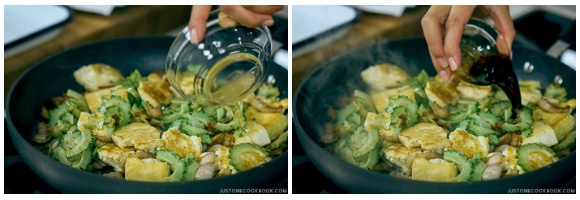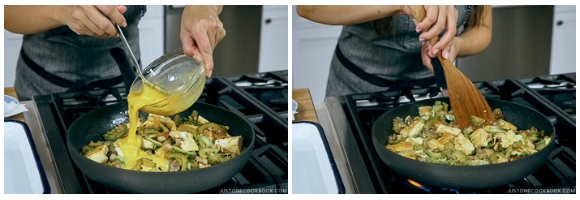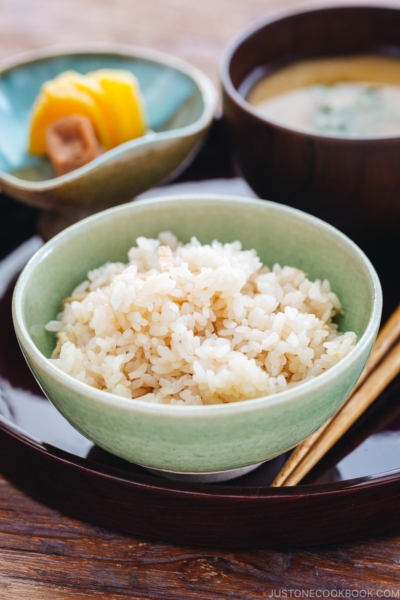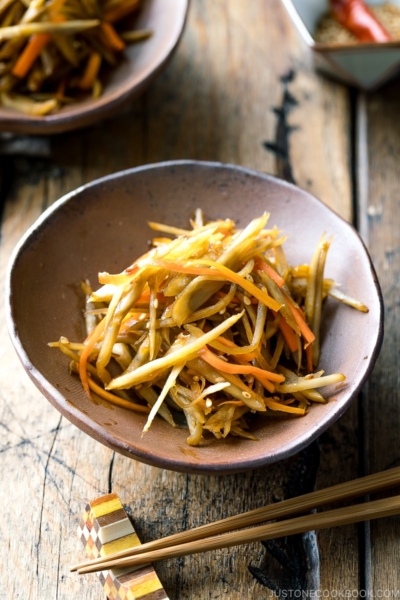Okinawa’s most iconic Goya Champuru is a bitter melon stir-fry with tofu, egg, and pork belly. This popular savory dish is a truly rustic yet well-balanced meal. You can serve it as your main entree with steamed rice and miso soup on the side.

Goya Champuru (ゴーヤチャンプル) is a popular stir fry dish that came from the sunny island of Okinawa in southern Japan. Made with vibrant green bitter melon, tofu, pork belly, and egg, it is packed with protein and nutrients.
As I am planning my first trip to Okinawa this winter, I am excited to discover many more delicious Okinawan dishes. But first, let me introduce this simple yet absolutely healthy home-cooked dish of Okinawa – Goya Champuru with you.
What is Goya Champuru?
Goya (ゴーヤ) is an Okinawan dialect of Nigauri (にがうり). In English, it’s bitter melon or bitter gourd. As you can probably guess, bitter melon is famous for its bitterness, but it is remarkably nutritious.
Chanpurū (チャンプルー) refers to Okinawan stir-fry dishes, meaning “something mixed” in Okinawan. Stir-fry dishes are a big part of Okinawan cuisine. There are different types of champuru. Usually, it contains tofu with some kind of vegetables, meat, or fish. Common ingredients include spam, pork, egg, bean sprouts, and bitter melon. Spam is not typically used in mainland Japan, but Okinawan cuisine uses spam due to the influence of the US Navy.
Growing up in Yokohama (Tokyo area) between the ’70s and ’90s, Okinawan restaurants were rare to find and I had never had a chance to try Okinawan dishes.
Through the NHK TV drama “Churasan” (ちゅらさん) broadcasted in 2001, many people became interested in Okinawan culture and visited Okinawa on vacation. The popularity of Okinawan food spread all over mainland Japan, and we started seeing more Okinawan restaurants everywhere. Even Japanese housewives started to cook Okinawan dishes at home.

5 Health Benefits of Bitter Melon
- Treats skin conditions. Bitter melon juice has powerful antioxidants with Vitamin C and A, which prevent premature skin aging, diminish wrinkles, reduce acne, and help in treating eczema. The amount of vitamin C in bitter melon is four times more than in lemon and five times more than in tomatoes. Usually, vitamins get lost by being cooked, but not for bitter melon, which is why it’s perfect to cook Goya Champuru
- Lowers bad cholesterol levels. Studies have shown that the juice from bitter melon significantly reduces the risk of heart attack and stroke and keeps the heart healthy.
- Helps maintain blood sugar levels. Studies have also shown that eating bitter melon on a regular basis significantly reduces the blood sugar level for patients suffering from type-1 and type-2 diabetes.
- Prevents cancer. Those bitter flavors contain components that reduce blood sugar levels and cholesterol. Studies have also shown positive correlations between eating bitter melon and preventing or reducing tumor growth in cervical, prostate, and breast cancer patients.
- Boosts your immune system. Bitter melon is a source of many different antioxidants that make it a powerful defense mechanism against illnesses in the body.
How to Choose the Bitter Melon
Bitter melon season in Japan is from July to September. These days, bitter melon is also available at farmers’ markets or Asian grocery stores in the US. For the best taste, choose bitter melon in a relatively smaller size with lots of bumps. The surface should be fresh and shiny green, and you want to pick one that feels firm to the touch.
How to Store the Bitter Melon
To keep bitter melon fresh for a longer time, remove the seeds and pith first as they go bad quickly. Make sure you remove the inner white pith clean as that’s where the bitterness most concentrates. After slicing, you can store them in an airtight container in the refrigerator for later use.
How to Reduce Bitterness of the Bitter Melon
I learned to sprinkle some salt, but I also heard that enhances the bitterness instead. Some suggest cooking in lightly salted boiling water, then again I heard the method also causes bitterness. I assume everyone’s grandma suggests different things and you just need to try out the method that works for you. I use the salt method as it draws out moisture with some bitter flavors.
This amazing gourd may have an acquired taste, but there are plenty of good reasons to eat it. In this homey Okinawan stir fry, crunchy crisp bitter melon is combined with soft creamy tofu and cooked in a delicious umami-rich dashi and soy sauce seasoning. It’s truly a healthy and everyday meal you can serve for the family. I’d like you to give it a try.
Do you have any experience cooking with bitter gourd (goya)? What are your favorite ways of cooking with it? How do you remove the bitterness of the gourd? Share with us in the comment below!
Other Bitter Melon Recipe


Wish to learn more about Japanese cooking? Sign up for our free newsletter to receive cooking tips & recipe updates! And stay in touch with me on Facebook, Pinterest, YouTube, and Instagram.

Goya Champuru
Video
Ingredients
- 1 bitter melon (8 oz, 227 g)
- 1 tsp Diamond Crystal kosher salt (for the bitter melon)
- 14 oz medium-firm tofu (momen dofu)
- 6 slices sliced pork belly
- 2 large eggs (50 g each w/o shell)
- 2½ Tbsp neutral oil (divided; to fry the tofu, bitter melon, and pork)
- ¼ tsp Diamond Crystal kosher salt
- ⅛ tsp freshly ground black pepper
- 1 Tbsp soy sauce
For the Katsuo Dashi
- 3 Tbsp katsuobushi (dried bonito flakes) (I use 1 (3 g) packet and more for garnish)
- ¼ cup boiling water (4 Tbsp)
Instructions
- Gather all the ingredients.

To Prepare the Ingredients
- First, make the katsuo dashi. Add 3 Tbsp katsuobushi (dried bonito flakes) into a measuring cup and add ¼ cup boiling water. Let it steep until you’re ready to cook. Right before you start cooking, strain and remove the katsuobushi (you can reserve it to make Homemade Furikake Rice Seasoning). Tip: Alternately, you could use a dashi packet or dashi powder in a pinch or Vegan Dashi for vegan/vegetarian.

- Cut 1 bitter melon in half lengthwise. Using a spoon, scrape out the seeds and inner white pith.

- Thinly slice the bitter melon crosswise about ⅛ inch (3–4 mm) thick. Sprinkle 1 tsp Diamond Crystal kosher salt and toss well. Let stand for 10 minutes.

- Meanwhile, wrap 14 oz medium-firm tofu (momen dofu) with a paper towel. Place a heavy flat object, like a cutting board, on top of the tofu to squeeze out the water. I use flat trays to sandwich the tofu and place a marble mortar on top.

- After 10 minutes, quickly rinse the bitter melon with water and drain well. I use a salad spinner to get rid of the moisture easily.

- Cut your 6 slices sliced pork belly into 1½-inch (3.8-cm) pieces.

- Beat 2 large eggs (50 g each w/o shell) in a medium bowl. Now, tear the drained tofu with your hands into bite-size pieces.

To Cook
- Heat a large frying pan and add 1 Tbsp neutral oil. Put the tofu in the pan.

- Try not to touch the tofu frequently. Cook until the tofu is browned and the moisture has evaporated. Transfer to a plate.

- Add 1 Tbsp oil to the same frying pan. Add the bitter melon and spread it out in the pan.

- Sprinkle with 1 pinch kosher salt and stir-fry until almost cooked. Transfer to a plate.

- Add ½ Tbsp oil to the pan and add the pork belly. Season with 1 pinch kosher salt and ⅛ tsp freshly ground black pepper. Stir-fry until nice and golden brown.

- Add the bitter melon and the tofu back into the frying pan.

- Add the katsuo dashi and 1 Tbsp soy sauce. Let the liquid evaporate while you toss to combine.

- Taste the dish. Add kosher salt and freshly ground black pepper, if necessary. Use salt to enhance the flavor instead of adding soy sauce.

- Add the beaten eggs to the frying pan and shake it to cook the egg. Once the egg is no longer runny, turn off the heat.

To Serve
- Transfer to a serving plate and sprinkle with more katsuobushi (bonito flakes). Enjoy!

To Store
- You can keep the leftovers in an airtight container and store in the refrigerator for up to 3 days or in the freezer for a month.









Before I cut the bitter melon in half and remove the seeds and pith, I take a carrot peeler and remove some of the green bumps on the outside as that seems to be very bitter. I will then boil the bitter melon for 15 minutes using water and a little bit of soy sauce..sometimes I may even sprinkle in a little bit of cinnamon.
Hi Philip,
Wow! Thank you for sharing your cooking experience and tips with us!
I’ll have to try making it your way one day.🙂
I grew up eating goya (ampalaya in my national language) and was missing it. So, I made this dish tonight. So happy!I It was so good. Thank you!
Hi JD,
Thank you very much for trying this recipe and for your kind feedback. I’m so glad to hear you enjoyed the dish!
When I was growing up, in our household, we used to cook bitter melon with canned sardines in tomato sauce, as well as coconut cream/milk, chili and pork (if pork was expensive, then canned sardines in tomato sauce).
Hi JD,
WOW! Thank you very much for sharing your cooking experience with us!
It’s so many ways to enjoy Goya! I’ll have to try making it your way one day.🙂
Nami-san! Love your beautiful website!!!
I’m from Surinam (small country over Brasil) but I live in the Netherlands. In Surinam we’re used to eating bitter vegetables (f.e. boulangé, a bitter kind of nasu). Sliced bitter melon (or Sopropo as we call it) is left in salty water for 30 minutes. Then rinse it and squeeze it until most of the water is out. Stove it together with chopped onion. Finally we add smoked salmon flakes to it and season it with some freshly grinded black pepper. Sometimes if we feel like eating it very spicy, we add a Madame Jeannette (a small yellow pepper) during the stoving proces. Delicious with a bowl of hot steaming rice! (Not low carb of course)
Hi Jeannet! Thank you so much for your feedback. It was interesting to hear about how the bitter melon is cooked there. Sounds like a delicious dish!
A simple and easy to follow receipe. I didn’t have belly pork but have some strips of belly sukiyaki and dashi stock previously made from Kombu Kelps and Katsuobushi in the freezer, which works out well! Also I didn’t use salt to remove the bitterness of the bitter gourd as we are quite used to eating as such, it turns out that the seasoning and cooking with other ingredient left no trace of any bitterness! We often stir fry bittergourd with black bean paste or make a soup with yellow beans, dried shrimp and pork bones. Also in southeast asia we love to stir fry it with sambal chilli. This Goya Champuru gives us a new dimension in cooking bittergourd, thank you for the recipe Nami!
Hi Bill! Thank you for trying out this recipe! Really happy to hear that you enjoyed this new way to enjoy bitter gourd. Thanks for your kind feedback. 🙂
Hi Nami-san,
Some people in my family do not like pork. Have you tried other meats that might be used as a substitute?
Thank you~
Theresa
Hi Theresa! I like pork in this recipe, but you can use other protein (beef, chicken, shrimp…) if you like. 🙂
Excellent recipe !! I made it without eggs. Bitterness: Add some jaggery to the Goya recipe before taking it off the heat. Jaggery is an unrefined sugar product made with Sugar cane in India. It’s “non-centrifugal sugar”. It has little salt taste.
Hi Raj! Thank you so much for trying this recipe and for your kind feedback. I’ve heard of jaggery before. Thank you so much for sharing your tip with us!
In the Philippines, bitter melon (or ampalaya) is a common vegetable. To remove the bitterness, we mix in a lot of salt to the sliced bitter melon then let is stand for at least 30 minutes. When we’re ready to cook it, we rinse it thoroughly and squeezed out the water by hand. For the cooking method, we saute onions, garlic, tomatoes then the meat (usually pork belly). Then we add water. When the water is boiling, we add the bitter melon evenly to the pan. We let it simmer until it’s cooked. We add beaten egg last then mix it up.
I’m curious about your recipe. I will try it sometime.
Hi Rizza! Thank you for sharing your tip! The Filipino dish sounds delicious!
Thank you! Your recipes had helped me a lot now that I’m living in Japan, those are very easy to follow and so delicious.
Hi Monica! I’m so glad to hear my recipes have been helpful. Thank you for trying them out! Hope you are enjoying your life in Japan so far. 🙂
Hechima stir fry
A few montes ago I took a class of Japanese cooking and got to meet a very nice lady who owns a farm and specializes in growing Asian vegetables!
I became a regular customer and started to experiment with all sorts of unfamiliar ingredients. During my last year visit to Okinawa, I tasted different Champuru recipes, so after trying my hand at your Goya Champuro recipe a while ago, today I cooked Hechima Champuro, which turned out to have a more subtle, but equally delicious flavor. Okinawan cuisine is really interesting, although very different from the rest of Japan.
Hi Rolanda! Wow, that’s so cool to know someone who has good produce! So nice that you could recreate the dish! Thank you for sharing the story with us!
Hello Nami!
I just made your recipe with only one alteration. I had no pork belly but I did have shrimp. It was insanely delicious! The slight bitterness left in the goya was just right. The combination of the dashi (your recipe!), the shrimp and the katsuobushi gave this dish a wonderful ocean, seafood umami flavor and my husband and I love it. There is a brand new Asian Supermarket in Boise and we went there yesterday for the first time. They have everything I need for your recipes! Anything Japanese, Chinese, Korean or Vietnamese – it’s amazing. The bitter melon was fresh and beautiful, btw. Okay, so, yes, delicious recipe and since I am diabetic, the goya will be a welcomed regular addition to my diet. I have been taking bitter melon capsules for just over 6 months and have brought my A1-c from 11.7 to 6.3! I have been experimenting with and cooking Japanese recipes for about 2 years now and I am obsessed! Guess who got me started….you! Thank you so very much.
Hi Nikki! I got so hungry by reading your description!!! And you live in Boise to get all the ingredients! That’s amazing! I see hope, and I really wish Japanese ingredients get spread all over the US! 🙂 How nice to hear your health is improving. I’m so happy to hear that. And thank you for cooking Japanese recipes from my site! Your kind feedback made my day!
NAMI
Reducing the bitterness of bittermelon: The bitter flavor is the result of the melon’s high quinine content. Like the heat in hot peppers, the bitterness of the melon is concentrated in the placenta (white pulp) and to a lesser extent the meat (green part) To remove the bulk of the bitter flavor, carefully trim away most or all of the white pulp and to further reduce (but never totally eliminate) the bitterness, blanch the cut pieces in boiling water with a little salt and sugar. The more surface area of the cut melon exposed to the boiling water, the less bitter it will be (i.e. thin stir-fry slices as opposed to thick chunks). The great thing about this is that now you know the source of the quinine, you can generally control the melon’s bitterness simply by the amount of pulp you trim away and how thickly or thinly you cut it!
“You shall know the truth and the truth shall make you free”!—True thing.
Your Pal in gobbling up the good stuff, Lo Fan Don
Thanks again Lo Fan Don!
Hi Nami! Lo Fan Don here again. Since your site seems to be mainly directed at Gai-Jin R Us, I’d like to share a recipe of mine with your readers who, we (and you) might find useful in their kitchens. Because I am a seriously polycultural cook (I cook and eat things that most Asians and a lot of others turn their noses up to) and absolutely love Asian cuisines, I’ve developed a number of shortcuts to take the tedium out of constantly having to prepare the same basic sauces and techniques over and over each time I want to prepare something. As one example, many, many Chinese recipes call for the same basic flavorings that can easily be combined into a single universal sauce that can be modified at will with minor additions of other ingredients to suit a particular recipe. I’m sure there’s others, but here’s my basic Lo Fan Don’s Secret Sauce:
1c oyster sauce
1/2c soy sauce
1/4c shao shing ginger wine*
1T@ brown sugar, minced garlic, minced ginger (or to taste)
Bring all this to a quick boil and bottle it for use. (I use a retired ketchup bottle) It lives forever in the reefer and hasn’t spoiled yet….
I use it primarily to season fried rice, for marinating meats prior to stir frying (with slight additions of black bean sauce, chili bean sauce, shrimp paste, more of this or more of that and so forth to suit the recipe) and even in place of soy sauce when I feel a recipe needs that little last second extra “boost” of “je ne sais quoi”…..
*Shao Shing Ginger Wine: I trim, peel, preserve and store my year’s fresh ginger at the beginning of the season when it’s beautifully fresh, tight and smooth and cover it in shao shing (Chinese) rice wine. It’s not necessary to cook or even refrigerate it and any time I want a little extra ginger flavor in a dish , use the ginger infused wine. I might also mention that I seldom if ever go to the trouble of making up any sauces that are commercially available like black bean garlic sauce, chili bean sauce and so forth when there are so many excellent brands already to go…(unless I’m showing off of course)!
Thanks again for your wonderful site!
NB.If you find any of this useful, go ahead and post as your own…..in the words of my Chinese slumlord, “I not care”!
This is wonderful! Thanks so much for sharing it with me and JOC readers!
Aloha, Nami! I was so excited to try your Goya Champuru recipe this past week! My father grows bitter melon and happily shared his recent harvest with me. Your recipe was easy to follow, and I always enjoy watching the video before cooking. My first bite of the champuru brought back wonderful memories of our family trip to Okinawa this past summer. Thank you for helping me to build my food connection to my Okinawan roots. Can’t wait to try more of your recipes! ????????
P.S. I loved the champuru so much….I made it not once, but twice this week. ????
Hi Lori! Your father grows bitter melons?! How lucky you are! I’m sure your champuru was extra delicious with your father’s fresh goya! I’m happy to hear you liked this recipe and thank you for your kind feedback. 🙂
This was amazing. Thank you so much for sharing.
Hi Rem! Thank you so much for trying this recipe! So happy to hear you enjoyed this dish. 🙂
今晩ゴーヤチャンプルーが少しい作りづらい事実を知った… T_T
Hi Nami! Thanks for the recipe! The goya in my local supermarket has been catching my eye for a while, but visiting Okinawa this summer pushed me to buy some. Making Goya Champuru a harder than it looks actually! In particular, the tofu didn’t go well. It took a long time to cook and each time I turned the pieces, the thin cooked layer stuck to the pan. Do you think it may have been too wet? I did dry it per your instruction. Any tips??
Hi there! Hmm it’s hard to say without being in your kitchen with you, but here are my thoughts from what you wrote.
1) Did you use a non-stick frying pan? If not, you will need to add more oil so tofu (or any ingredients) won’t stick. Otherwise, tofu shouldn’t stick too bad.
2) Tofu took a long time to cook – Maybe the heat was a bit weak? Tofu can be eaten fresh (as it is), so purpose is to heat up and brown for nice char look.
3) Tofu releases water even though you wipe – but with heat, it should be evaporated as you cook.
So changing a pan or adding more oil and use higher heat may help?